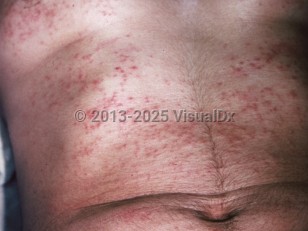Seabather's eruption in Adult
Alerts and Notices
Important News & Links
Synopsis

Seabather's eruption is caused by envenomation by and subsequent hypersensitivity to the larval form of marine coelenterates encountered in seawater. Larvae of the thimble jellyfish, Linuche unguiculata, are the cause of eruptions in the Atlantic Ocean off the southeastern coastline of Florida, Mexico, and the Caribbean. It has also been noted to occur in the Philippines and other areas of coastal Southeast Asia with Linuche aquila as the causative organism. While the adult jellyfish measures 5-20 mm (up to 3/4 inch), the larval form is only 0.5 mm. Off the coast of the mid-Atlantic up through New York, the larvae of the sea anemone Edwardsiella lineata have also been identified as causal. Most cases occur between March and August.
Some refer to seabather's eruption as "sea lice," although this is a misnomer, as true sea lice are skin parasites of fish that do not affect humans.
Envenomation, primarily triggered by pressure and friction, occurs when the larvae get caught beneath swimwear and stinging cells (nematocysts) discharge into the skin.
The condition typically presents within minutes to 1-2 days after patient emerges from seawater as a pruritic, urticarial, and/or papular rash in the distribution of their bathing suit or other areas of pressure including surfboard contact. Symptoms usually persist for 5-7 days but may persist for up to 2 weeks or longer. Some patients may develop fever, headache, malaise, and emesis (especially children). Conjunctivitis and urethritis may develop if exposure to those mucous membranes occurs. Systemic hypersensitivity reactions, including anaphylaxis, are rare in jellyfish envenomations. Rarely, the rash may recur within 2 weeks, and atopic individuals may have lesions for up to 6 weeks.
Risk factors include age younger than 16 years, a past history of seabather's eruption, and surfing. Showering without a bathing suit after seawater exposure has been found to be protective. Having a history of seabather's eruption increases the risk of future episodes, which supports the theory that this condition is due to underlying hypersensitivity. Some individuals are apparently immune, however, and do not develop a rash despite similar, repeated exposures in the same seawater as those who are symptomatic. No deaths have been reported.
Some refer to seabather's eruption as "sea lice," although this is a misnomer, as true sea lice are skin parasites of fish that do not affect humans.
Envenomation, primarily triggered by pressure and friction, occurs when the larvae get caught beneath swimwear and stinging cells (nematocysts) discharge into the skin.
The condition typically presents within minutes to 1-2 days after patient emerges from seawater as a pruritic, urticarial, and/or papular rash in the distribution of their bathing suit or other areas of pressure including surfboard contact. Symptoms usually persist for 5-7 days but may persist for up to 2 weeks or longer. Some patients may develop fever, headache, malaise, and emesis (especially children). Conjunctivitis and urethritis may develop if exposure to those mucous membranes occurs. Systemic hypersensitivity reactions, including anaphylaxis, are rare in jellyfish envenomations. Rarely, the rash may recur within 2 weeks, and atopic individuals may have lesions for up to 6 weeks.
Risk factors include age younger than 16 years, a past history of seabather's eruption, and surfing. Showering without a bathing suit after seawater exposure has been found to be protective. Having a history of seabather's eruption increases the risk of future episodes, which supports the theory that this condition is due to underlying hypersensitivity. Some individuals are apparently immune, however, and do not develop a rash despite similar, repeated exposures in the same seawater as those who are symptomatic. No deaths have been reported.
Codes
ICD10CM:
T63.691A – Toxic effect of contact with other venomous marine animals, accidental, initial encounter
SNOMEDCT:
238534006 – Sea bather's eruption
T63.691A – Toxic effect of contact with other venomous marine animals, accidental, initial encounter
SNOMEDCT:
238534006 – Sea bather's eruption
Look For
Subscription Required
Diagnostic Pearls
Subscription Required
Differential Diagnosis & Pitfalls

To perform a comparison, select diagnoses from the classic differential
Subscription Required
Best Tests
Subscription Required
Management Pearls
Subscription Required
Therapy
Subscription Required
References
Subscription Required
Last Reviewed:06/18/2019
Last Updated:06/19/2019
Last Updated:06/19/2019
 Patient Information for Seabather's eruption in Adult
Patient Information for Seabather's eruption in Adult
Premium Feature
VisualDx Patient Handouts
Available in the Elite package
- Improve treatment compliance
- Reduce after-hours questions
- Increase patient engagement and satisfaction
- Written in clear, easy-to-understand language. No confusing jargon.
- Available in English and Spanish
- Print out or email directly to your patient
Upgrade Today

Seabather's eruption in Adult

